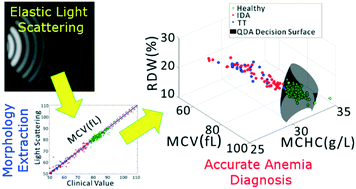Our official English website, www.x-mol.net, welcomes your feedback! (Note: you will need to create a separate account there.)
Screening of nutritional and genetic anemias using elastic light scattering†
Lab on a Chip ( IF 6.1 ) Pub Date : 2018-09-28 00:00:00 , DOI: 10.1039/c8lc00377g Lieshu Tong 1, 2, 3, 4 , Josef Kauer 5, 6, 7, 8, 9 , Xi Chen 10, 11, 12, 13, 14 , Kaiqin Chu 1, 2, 3, 4 , Hu Dou 10, 11, 12, 13, 14 , Zachary J. Smith 1, 2, 3, 4
Lab on a Chip ( IF 6.1 ) Pub Date : 2018-09-28 00:00:00 , DOI: 10.1039/c8lc00377g Lieshu Tong 1, 2, 3, 4 , Josef Kauer 5, 6, 7, 8, 9 , Xi Chen 10, 11, 12, 13, 14 , Kaiqin Chu 1, 2, 3, 4 , Hu Dou 10, 11, 12, 13, 14 , Zachary J. Smith 1, 2, 3, 4
Affiliation

|
Anemia affects more than ¼ of the world's population, mostly concentrated in low-resource areas, and carries serious health risks. Yet current screening methods are inadequate due to their inability to separate iron deficiency anemia (IDA) from genetic anemias such as thalassemia trait (TT), thus preventing targeted supplementation of oral iron. Here we present an accurate approach to diagnose anemia and anemia type using measures of pediatric red cell morphology determined through machine learning applied to optical light scattering measurements. A partial least squares model shows that our system can accurately extract mean cell volume, red cell size heterogeneity, and mean cell hemoglobin concentration with high accuracy. These clinical parameters (or the raw data itself) can be submitted to machine learning algorithms such as quadratic discriminants or support vector machines to classify a patient into healthy, IDA, or TT. A clinical trial conducted on 268 Chinese children, of which 49 had IDA and 24 had TT, shows >98% sensitivity and specificity for diagnosing anemia, with 81% sensitivity and 86% specificity for discriminating IDA and TT. The majority of the misdiagnoses are IDA patients with particularly severe anemia, possibly requiring hospital care. Therefore, in a screening paradigm where anyone testing positive for TT is sent to the hospital for gold-standard diagnosis and care, we maximize patient benefit while minimizing use of scarce resources.
更新日期:2018-09-28



























 京公网安备 11010802027423号
京公网安备 11010802027423号